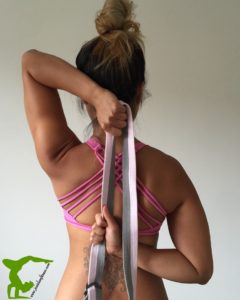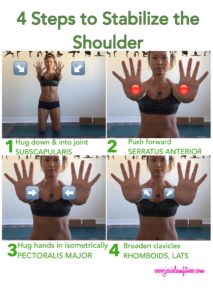Someone told me they were told that their scapula winged out (shoulder blade sticks out) because they were small and skinny and it’s “normal” for thin Asian girls LOL! ?
Well…maybe
But that is also a sign that your shoulder stabilizers are weak and they need to be strengthened to protect this vulnerable joint. This can prevent or slow down degeneration, improve posture, breathing, and in turn reduce stress, assist with proper movement, and help you LOSE UNWANTED FAT! (Do I have your attention now? Lol)
So check your plank and push up technique, the abduction of your arm, and your cow face pose (shown here)
If you have wrist pain that didn’t come from direct injury to the wrist, fix your shoulder!
The glenohumeral joint, or the “shoulder joint,” is a ball and socket joint. This means it allows for the most movement. Unlike the hip, it is much less stable with less encapsulation, it’s almost like a golf ball and tee. We need to enforce active stability for proper health and function of this joint or it can lead to impingement, excess shearing force, tension or weakness, all leading to joint damage and wear.
There r two ways to stabilize the shoulder joint
 stabilize the humeral head (top of the upper arm bone) via the rotator cuff muscles
stabilize the humeral head (top of the upper arm bone) via the rotator cuff muscles
 stabilize the scapula (shoulder blade) via the rhomboids and serratus anterior muscles
stabilize the scapula (shoulder blade) via the rhomboids and serratus anterior muscles
Winging of the scapula is an indication that your a scap is unstable and serratus is weak (and your awareness of it is weak). You can see this with GOMUKASANA, push ups against the wall, and abduction of the arms. If the shoulder blades have a lot of movement, they aren’t stable.
The serratus anterior is a respiratory muscle and a very important stabilizer. When the serratus is solid, movement from the bigger muscles (lats, delts) is more efficient and you can generate more force without hurting yourself.
Here is how u can strengthen the serratus anterior: scapula push ups aka serratus push ups
Progress from middle of the room, to the wall, to table top, to plank
– arms stay straight but not hyper extended
– Focus on serratus
– Upper traps and neck relaxed
– Notice the movement of the scapula (towards and away from the spine)
– Perform 15 reps or 1-3 sets daily
Let’s put it all together
The 4 rotator cuff muscles all attach to the scapula and wrap around the humeral head, like a CUFF – I finally realized how they got the name lol 
These are:
- supraspinatus
- infraspinatus
- teres minor
- subscapularis
So by stabilizing the humeral head and the scapula, you can stabilize the joint itself to restore function and create movement with the bigger muscles so you can get stronger, develop visible muscle definition, achieve that “toned” look, and not hurt yourself! Be patient!
4 steps to stabilize the shoulder
 hug down and into the joint: activating subscapularis (in the armpit), to turn the triceps in and soften the upper traps
hug down and into the joint: activating subscapularis (in the armpit), to turn the triceps in and soften the upper traps
 push forward: Activate serratus anterior (you need these muscles to perform awesome push ups in perfect form!)
push forward: Activate serratus anterior (you need these muscles to perform awesome push ups in perfect form!)
 hug the hands in isometrically: pretend you are squeezing an imaginary ball between the hands. Isometrically means your force meats the force of gravity, no more, no less. Activate anterior delt and pecs
hug the hands in isometrically: pretend you are squeezing an imaginary ball between the hands. Isometrically means your force meats the force of gravity, no more, no less. Activate anterior delt and pecs
 broaden clavicles: spread collar bones apart. Activate back muscles – rhomboids and posterior delt
broaden clavicles: spread collar bones apart. Activate back muscles – rhomboids and posterior delt
*source: @yoga_medicine shoulder module manual
These are all small and subtle movements that require control and awareness of the deeper muscles. If you engage TOO VIGOROUSLY, it can restrict the scapula movement and we still want some movement. Just not out of control and all over the place.
Once you got this, check out my push up tutorial to put these babies into action!
—



